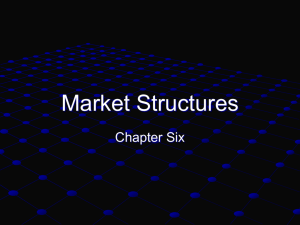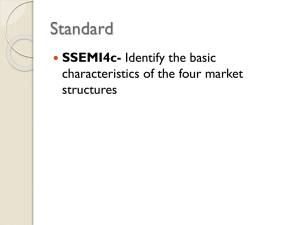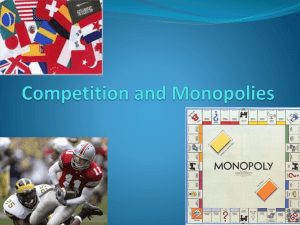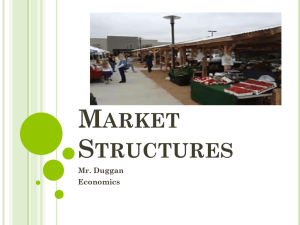Highly Competitive Markets
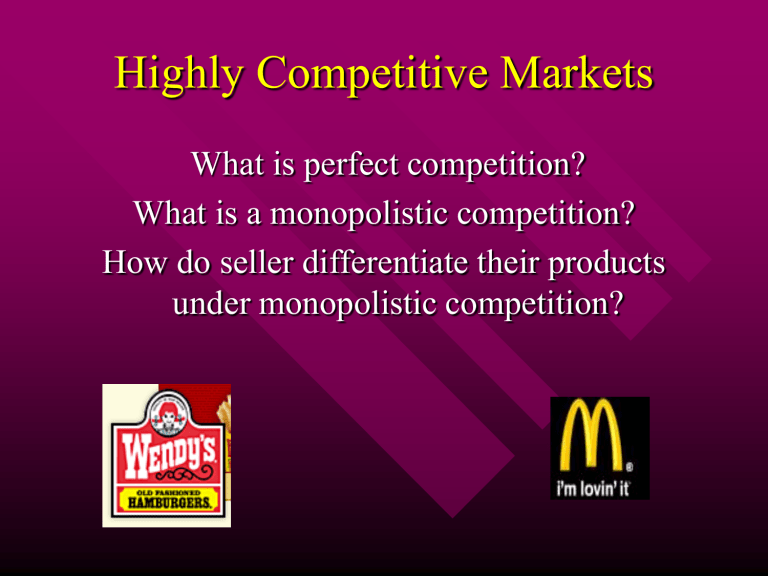
Highly Competitive Markets
What is perfect competition?
What is a monopolistic competition?
How do seller differentiate their products under monopolistic competition?
Perfect Competition
– An ideal market structure in which buyers, or consumers, and
Seller(producers), each compete directly and fully under the laws of supply and demand.
Many Buyer and Seller
– No one single buy or seller in a market has enough power to control demand, price, or supply
– Buyers and sellers must act independently
Identical Products
– Sellers offer identical products
– Buyers must make purchasing decisions
– Non identical product
» Monopoly – 1 seller controls all production of a good and service
Perfect competition as a model
Informed Buyers
– Buyers a knowledgeable about a product
– $ and quality of goods and services
Easy Market Entry and Exit
– Leave = No Profit
– Entry = Profit
PERFECT COMP.
Model
– Ideal Completive
Market Structure
– (See over head)
Monopolistic Competition
– Sellers offer different, rather then identical, products.
» Similarities- both (B) and
(S) compete under the law of supply and demand
» Both (B) and (S) act independently of each other
Product Differentiation
– Seller point out the differences between each other trying to set them selves apart
Non Price Competition
– How seller differentiate products
– Compete on the basis other than price
» Ex jeans
Profit
– Main goal is to increase (P)
» See Graph
Review Questions
What four conditions must exist for a market to be perfectly competitive?
How does monopolistic competition differ from perfect competition?
How do sellers in monopolistic competition compete with one another?
Objectives
– How is an oligopoly structured?
– What is a monopoly?
Imperfectly Competitive Markets
Oligopolies
– Only a few sellers
– Sellers offer identical or similar products
– Other sellers cannot enter the market easily
Oligopolies at Work
– Non price Competition
» Control Price (Cereal)
– Interdependent Pricing
» Dependent upon $ of competitors
» Price leadership- biggest seller sets the price
» Price War- sellers undercut each other to gain a share of the market
– Collusion
» Sellers secretly agree to set production levels or price
–
Cartels
» Companies openly organize a system of price setting and market sharing
– Single Seller
– No close substitute goods are available
– Other sellers cannot enter the market easily
Types of Monopolies
– Natural Monopolies
» Single seller that makes good and services most efficiently
» Economies of Scale
Seller’s large scale, or size helps it use all resources more efficiently and economically than if divided
Geographic Monopolies
– Market’s potential profit is so limited by its geographic location that only a single seller enters the market
Technological Monopolies
– Producers develop new technology that enables the creation of a new product or change the ways an exiting product is mad
» Patent
Government Monopolies
– Government is the sole seller of a product
– Provides public goods
@ Work
– Can’t charge any price they want:
3 Forces limit the seller’s control over price:
– Consumer Demand
– Potential Competition
– Government
Regulations
Review Questions
Compare the Characteristics of oligopolies and monopolies.
What are the four main types of monopolies? Under what conditions do they tend to arise?
Identify the factors that affect price in oligopolies and monopolies.
Key Terms of Era of Big
Business
– Trusts- group of companies that combine to eliminate competition in an industry
– Laissez-faire- “let {the people} do {as they will}
» No government involvement in business
Antitrust Legislation
– Act designed to regulate
Big Business

